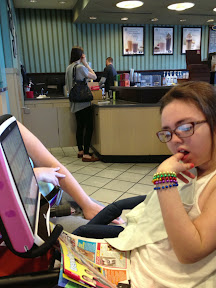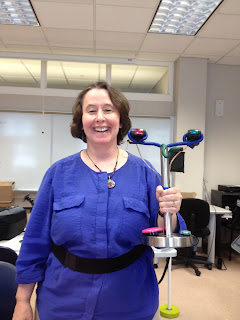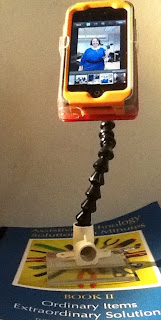.jpg)
Switch skills are a basic in classrooms for learners with multiple or significant disabilities. Switches give
children (and adults) with limited motor skills the ability to control nearly anything.
Unfortunately many teachers, paraprofessionals and others working with our students do not receive much training in teaching switch use. Some assume that the ability to hit a switch for cause and effect activities (make the toy walk or make the computer game change) is the ultimate goal, but that isn't true. A switch or switches are a means to an end. The switch is a tool for controlling other things - toys, games, appliances, computers, power wheelchairs and more. Teaching switch use is about moving from learning what the switch does
to learning to use the switch to do things. Our goal should never be to "activate the switch 10 times in 30 minutes" or "in 8 out of 10 trials"; instead our goal is to complete a task, be it leisure, vocational, academic or something else using a switch or switches.
Many of our students get "stuck" on cause and effect, not because they aren't capable of more, but because we don't know how to tell when they are ready for more or what to do next. Once a child can activate a switch and anticipates/attends to what the switch does they are ready for more. If you are not sure if they are anticipating or attending then make the,
"least dangerous assumption" and presume competence and move on.
Ian Bean has a great slide show you can look at called, "Beyond Cause and Effect." The free
Switch Progression Road Map is also a must read.
What do we do next? That depends. If the child is capable of using two switches then we introduce a second switch. This might be two switches at the hands or sides of the head; it might be one
at the hand and one at the head; it might be two finger switches or one at the left elbow and one at the right knee...
the possibilities are endless. Whatever two locations the child is able to activate deliberately and with control. The first learned switch site usually (but not always) becomes the "chooser", "selector" or "this one" switch. The new switch site becomes the "mover", "scanner" or "
not this one" switch. Now the student begins work on two switch scanning. Don't worry if the student doesn't "get it" at first, it is a learning process! Moving beyond that single switch for cause and effect is a huge gift you are giving your student! Linda Burkhart has a
great hand-out on moving from cause and effect to two switch scanning . See below for software and websites to use to work on
two switch scanning.
Here is a link to an animation of two switch scanning.
What happens if the child is only able to activate a single switch? Well, no matter the location of the switch, we start to work on timing the switch hit. If the child can see and hear we start working with an auditory and visual scan with a long enough pause over each choice for the student to decide and activate the switch. If the child has
vision or hearing difficulties we enhance the scan to accommodate for challenges, verbal prompts for a student who has vision issues, bright lights or colors that correspond with the scan for those with hearing problems, tactile cues such as vibration for students who are deafblind. You can see an animation of
single switch scanning
here.
There are many companies which sell software for teaching switch use and there are two companies which
sell subscriptions to online switch activities. Additionally there are now apps for iPad and Android to teach switch skills. Again it is advisable to avoid software or apps, especially expensive ones, which focus ONLY on cause and effect, the goal is to move students past this as soon as possible. (Note this list is of software that teaches switch use and is not inclusive of all switch accessible programs or apps.)
Software:
Judy Lynn Software
Inclusive TLC
Marblesoft
Online Programs:
 |
A comparison of two online, subscription based switch programs.
|
Apps:





.jpg)

.jpeg)




